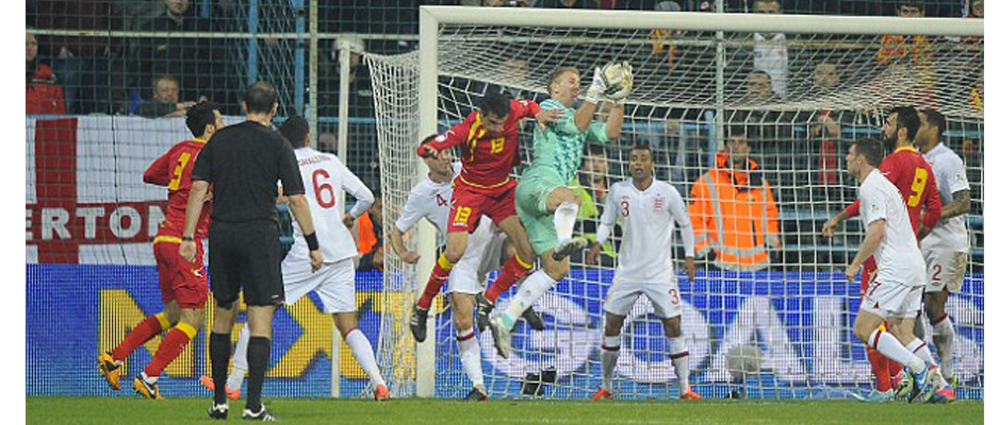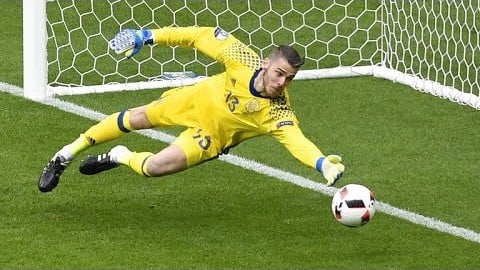Looking for a goalkeeping guide? The goalkeeper’s role is probably the toughest in football, especially modern football, where more responsibilities have been added in not only saving your goal but also building attacks from the back.

A goalkeepers job is one of the scariest elements in the game of Football as they are either criticized for missing a goal or overshadowed by the performance of other ten players.
The goalkeeper’s job in football is one of the most unforgiving jobs in football- you make a mistake and the knives are out. If you perform well, your performance will be overshadowed by the attackers or midfielders, who, most often than not, hog the limelight.
So, what does it take to be a goalkeeper and what are the key things to look out for? Here is your essential guide to goalkeeping.
The Basics
Before getting between the sticks, goalkeepers must equip themselves with the right gear. The kit colour of the goalkeeper has to be different to the outfield player to differentiate the goalkeeper from the rest of the team.
All goalkeepers have to wear goalkeeping gloves – although it is not mandatory to wear them – to protect fingers, the palm and wrist from injuries.
The first and most important tip for being a goalkeeper is to know where the goal is. It may sound simple, but it is vital for a goalkeeper to know where he should be positioned when the opposition attackers are rushing towards him.
It takes only a matter of seconds for the attack to approach the goalkeeper and in the melee, the goalkeeper might lose track of where he is standing.
It is imperative that the goalkeeper stands in the centre of the goal when his team do not have the ball. The goalie has to be ready for a shot to come in at any time and positioning himself in the middle gives him ample time to move either side.
This is the first and most important rule of goalkeeping:
Positioning is key for a goalkeeper to save shots as much as a good technique with hands and feet. When the attacker is approaching from the sides of the goal, the goalkeeper must position himself on the near post, cutting off the opportunity for the attackers to score on the near side.
Goalkeepers must also position themselves out of the goal, nearer to the six-yard box or further, to rush when the opposition attack has beaten his team’s defenders.
Too far out may tempt the opposition players to shoot from a distance; standing at the line may make it harder to put the attacker off by rushing towards the ball.
Catching And Punching
The goalkeeper’s foremost duty is to keep the ball away from his goal. He can push the ball away from the goal with his hands by either catching or punching it.
To catch the ball, the goalkeeper must hold it like cradling a baby to his chest, with his hands underneath the ball if it is below his chest, and the other way if it is above his chest. It is essential for the goalkeeper to get his body behind the ball while catching.
The goalkeeper must not catch the ball away from his body as there is a chance that the ball may slip through his fingers and go into the goal.

The goalkeeper should place the ball closer to his body while catching it as loose grip may slip the ball through his hands.
The goalkeeper must always be alert and ready to dive either side, as well as down and up as the ball can come from any direction.
While catching a low ball, the shoulders have to take the impact while falling to the ground (always dive sideways and not face/back first), and ensure that you hold on to the ball.
While training to be a goalkeeper, footwork is key. Quick steps and shuffles to either side have to be practised without the ball and then with the ball being thrown to each side.

The goalkeeper must always be alert about his surroundings as one cannot predict the turns a game can take.
Goalkeepers will also have to train to recover and get up quickly to possibly save another shot. After catching the ball, the goalkeeper can dive to the ground, with the ball facing the ground, to protect the opposition’s attackers from kicking the ball.
[pullquote]Balls put into the box at height can be punched away by the goalkeeper if there are many opposition attackers in and around him. [/pullquote]
While punching the ball, goalkeepers must jump with one knee high, to get a good push off the ground, and punch using the top of their hands.
Your hands must be formed like a fist with the thumb to the side (do not put the thumb inside the four fingers as it may cause injury while punching the ball away).
Goalkeepers can either use one or two hands to punch the ball away.
Playing With The Ball At Feet And Hands
Like outfield players, goalkeepers must also train to play with their feet and is becoming incredibly important in the modern game. Earlier, goalkeepers were expected to hit the ball long from a goal kick or clear it away, but the modern game requires goalkeepers to make short, quick passes from the back or even bring the ball out into the defence and start attacks.
It is important for the goalkeepers to do short, quick and precise passes so that the opponents do not get a chance to take the ball.The goalkeeper has the best seat in the house and can dictate play from the back by launching a long field ball to catch the opposition off guard and feed his striker. This can especially be done from a set-piece situation when the opposition team have many players in the goalkeeper’s half.
[pullquote]Modern-day goalkeepers, as mentioned above, have to be good with their feet and distribute the ball to his defenders and midfielders, and be expected to be available to short kicks and passes. [/pullquote]
Goalkeepers, unlike other outfield players, can also use their hands to throw the ball and start attacks. Goalkeepers can use a variety of techniques to throw the ball to a teammate, including rolling it to the ground, an overhead throw, like how a cricket bowler bowls a ball, or with a sideways action.
Goalkeeping During Set-Pieces
A goalkeeper’s role in a game becomes very important during set-piece situations, either a free-kick or a corner kick. If it is a free-kick, the goalkeeper must set-up a wall.
Defensive walls have to be set-up keeping in mind the distance from goal and the angle. If it is too far away from goal, a 3 or 4-man wall is sufficient. Closer to the goal would require a wall of more players.
During corner kicks, the goalkeeper must first tell his defenders to mark the opposition’s attackers and organise the box before the corner, and add two men on the posts, if required.
The goalkeeper must stay in the middle of the goal, and should always try to catch the ball or tip it behind the goal. Punching may not help if he stays on the line, but if he decides to run out of the line to clear the ball, he can punch it.
A goalkeeper must always punch the ball to the sides and not the middle as an opposition player may be lurking outside the box to take a shot on goal.
FOLLOW US ON INSTAGRAM FOR SPORTS MEMES AND REELS!





0 Comments